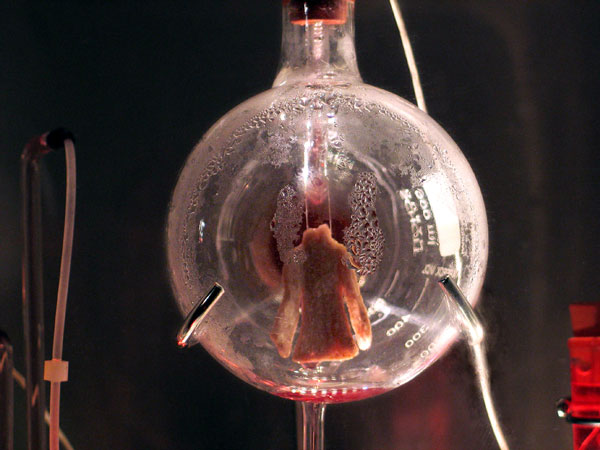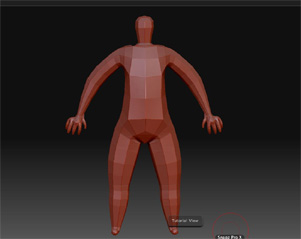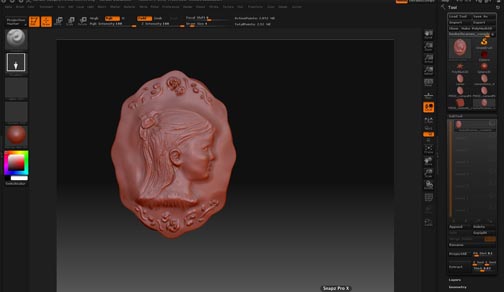3D
Frankensteinian Art?
My studies of researching digital technology and incorporating it into my traditional sculpting processes is part of what I am doing for my graduate degree at Goddard. It has taken me to places I would have never dreamed of going. Several months ago while researching 3d printers I began to realize that individuals were pushing anything they could through the printers to see what would happen, metal, ceramic, even glass. It was then that I wondered about biology. And I was certainly thrown for a loop when I found that they were printing bone, skin and now even organs. I wrote about this and had several links to articles about the subject in the October 28th blog article, I’m a genius! 3D Printing of the Human Organs?
I did, at that time, however, happen upon another artist’s work that after finding and reading I quickly clicked off of. The project has haunted me since then. There was such uneasiness when I first happened upon it that I didn’t even put it in my college bibliography. I am wondering now, why. Why am I so uneasy? It was exciting for me to find that science is now printing biology, and that someday, if I need a kidney I might be able to have my own kidney printed. But incorporating this other type of biology into art left me feeling uncomfortable. The topic has come up more than once since this first encounter with Stelarc’s art piece The Partial Head. The Partial Head is a prosthetic portrait of the artist that is computer generated and can talk to the viewer. This portrait is digitally printed and then seeded with living cells. Of course, the artwork needed a bioreactor/incubator circulatory system to survive. It only lived a week before becoming contaminated and “died.”
The Partial Head website acknowledges the collaboration of, The Tissue Culture & Arts Project (TC&A). http://www.tca.uwa.edu.au/ In a Leonardo Journal, article entitled, Growing Semi-Living Sculpture: The Tissue Culture & Art Project by Oron Catts and Ionat Zurr it state that they use “living tissue to create/grow semi-living object/sculptures and to research the technologies involved in such a task.” I need to examine, in my own mind, why creating organs to extend life, and using living cells to create art feels so different to me. Though both remind me of the scene from the movie Frankenstein.
Victor Moritz: Henry – In the name of God!
Henry Frankenstein: Oh, in the name of God! Now I know what it feels like to be God!
Is it my cultural upbringing that makes me uneasy about this? I have warned myself to be careful. Some fear is healthy; it does keep us from danger, however, it can also keep us from exploration. The difficulty is in knowing when have we gone too far.
Doctor Waldman: You have created a monster, and it will destroy you!
Another Sterlarc’s project consists of growing a 1 /2 scale ear. In another piece of art titled. Victimless Leather The TC&A project works at initiating a discomfort in the viewer as they digitally print a miniature coat over scaffolding with tissue that looks like — human skin.
Of course, growing things can be found everywhere. How is this technology any different than growing a topiary over a metal structure that becomes a living thing that will grow and I must tend? There are many ethical questions raised with TC&A ‘s project. For example, “Do these entities contribute to the objectification of living organisms?” In my previous comparison I honestly don’t feel that I am objectifying the ivy on the topiary. Nor do I feel I am killing portions of it when I prune the art. How is this different? Are we enthused with our control over the living material? This Frankensteinian idea towards art was also expressed in a recent Art and Technology podcast that I conducted with Robert Michael Smith. It appears these questions will continue to be raised and that artists that are presented with tools to push their creative limits and to initiate a reaction in the viewer will do so. It has certainly initiated a reaction from me. It will continue, and we just may see more art that for lack of a better word, can be referred to as Frankensteinian.
TC&A also examines, “the gap between the fast pace of development in science and technology and the slower pace of cultural understanding and adaptation.” They are indeed pushing the limits of acceptance both socially and culturally. They hope that the term “semi living object/products and sculptures” will make the art more palatable. “Our art challenges many people to examine their perception of the boundary between the living and the inanimate:” Their goal is get these projects to a point where the art can live out of their contained environment and provide tactile interaction with the viewer. I’m sure this will not be the last you hear about this subject on this blog, or the Art and Technology podcast. But I’m interested in knowing what other people feel about these works of… “art?”
Look! It’s moving. It’s alive. It’s alive… It’s alive, it’s moving, it’s alive, it’s alive, it’s alive, it’s alive, IT’S ALIVE!
Henry Frankenstein
( Oron Catts will be one of my up and coming interviews ( INTERVIEW) on the Art and Technology Podcast listen from the Digital Sculpting.net website or Subscribe to the podcast in itunes ) This podcast was recorded May 23, 2010 and will be up at the http://www.digitalsculpting.net website by May29th.
If you are reading this blog post from facebook and do not see the videos and or photographs visit https://creativesculpture.com/blog
Antiquities, Masterpiece, Rights of Ownership and 3D Scanning
I have been spending some time looking at historical artifacts and the copyright and ownership issues surrounding them. The reason why this topic has created some interest to me is that I’m curious about the advancement and tremendous increase in 3D scanning of artifacts.
It seems there are benefits in the 3d scanning of these precious items. There may be information captured by the scanner that will help scientist know more about the item. It offers an opportunity to document and make accessible the information. For example, the tomb of Tutankhamun is being scanned in hopes of preserving it so that the experience and information can be made available to those interested without actually having to make it accessible for individuals to experience it. This is important because the experiencing of some artifacts causes more damage to them. And it can be an asset in the restoration of an artifact.
Recording the tomb of Tutankhamun from factum-arte on Vimeo.
I have been cautioned not to just embrace all of this new technology without trying to thoroughly examine it. So, I must ask myself, what are the cons of having the artifacts scanned in 3D? Before I answer that, I thought it would be appropriate to look at some of the issues and questions revolving around the artifacts themselves.
For example:
- Is it ownership that is important or access?
- If I own land and I dig something up on my land. To whom does it belong? It will depend on the country you are in and the laws within that country. The antiquity may not belong to you. If it did not, would I report it or would I be more inclined to cherish my treasure without saying a word ?
- Many laws are developed in hopes of preventing looting of antiquities. Do they actually accomplish this? How do these laws effect poorer countries?
- How do I feel about cultural property?
- If something is taken or looted what happens to “the loss of context?” Having a coin but knowing where it was found or what the people who had this coin did, ate, where they slept, is important. It is not just the object that is researched, but where it was found.
How important is it for individuals to be exposed to the cultures and antiquities of those around the world? Should countries horde their antiquities? If antiquities can be distributed through trade, what happens with countries that have nothing to trade? How do they expose their people to the cultures around the world?
According to an article that I read, if I happened upon a stolen or found object and it ended up on the desk of an archeologist and it had something of importance on it, that information cannot be published. How difficult it must be for the archeologist who happens upon this. The reason— it has no legitimate provenance and the Archeological Institute of America forbids it. Why? If the archeologists should transcribe it and publish it, then they would be determining its authentication and making it more valuable.
Identity, self esteem, illicit digging, artifacts, private/market all of these words initiate a tremendous amount of passionate opinion in the information that I was reading about this subject.
Should there be a cultural common? Shared information and artifacts between countries, museums and collectors. The Brooklyn museum is making some of their artifacts, for which they hold the copyright, available on a Creative Commons License. Those who want to use them for non commercial use can do so. But, how is this policed?
I would suppose that the same questions and concerns that are found with traditional masterpieces and antiquities will apply to 3D scanned artifacts. Who owns them? Should they be reproduced? And my biggest thought is, that it is much easier to steal a data file than it is a physical dated fossil.
I also wonder about the artists who might use these artifacts as part of their own work. In the case of artists Barry X Ball, whose work I absolutely love, I have questioned this. Ball has taken digital scans of two Braoque pieces, “Masterpieces in the permanent collection of Ca’Rezzonico, Venice— La Purità (Dama Velata), by Antonio Corradini, and La Invidia by Orazio Marinali, as well as Hermaphrodite Endormi from the Louvre, Paris.” and he has digitally scanned them. Then he recreates them using digital milling in another substance. Does he sell these? Can he sell these? Is this art? Can he copyright this as his own?
So I ask the question, What are the pro’s and con’s and more importantly, what are the questions I should be asking when looking at this new technology of 3D scanning as it pertains to masterpieces and artifacts?
( I do hope to cover more podcasts on this subject. Looking for lawyers working with antiquities)
If you are reading this blog post from facebook and do not see the videos and or photographs visit https://creativesculpture.com/blog
I Am So Excited. I Just Scored Two More Interviews For The Art And Technology Podcast!
Each person I ask is because I am very interested in what they are doing, researching, or their place in this field. Do you want to know the two? Yes, more global interviews courtesy of Skype!
Adrian Bowyer- Bath
From Mr Bowyers website. “I am a senior lecturer in the Department of Mechanical Engineering at the University of Bath working in the Biomimetics Research Group on the RepRap Project and the Bioaffinity Applications Laboratory.” I thrilled about this interview. I have posted some wonderful videos about this man and what he has been doing. I love the idea of the RepRap. For those of you who don’t know what that is, a Rep Rap is a printer that prints objects in 3d, but no one that you are going to spend hundreds of thousands of dollars on. It is an open source project. You could build one of these for your own office/studio. I want one! Oh yeah, Did I mention that the RepRap can print itself?
Andrew Silke- Sydney, Australia
Mr Silke’s webiste the Guerrilla Cg Project states, “Andrew Silke is a professional animator and founder of The GuerrillaCG Project. With over 8 years experience he has worked on major feature films such as Happy Feet, Scooby Doo, and James Cameron’s new movie Avatar as well as creating award winning short films like as ‘Cane-Toad’ (with David Clayton).”
“The GuerrillaCG Project is a free non for profit organisation that hopes to make it easier to learn high-end computer graphics. We are building a team of volunteers to create videos, that describe in an easy and understandable manner, the fundamental concepts of computer graphics. ” I love this site and Mr. Silke’s dedication to education. If you are new to digital technology or a traditional sculptor needing to begin to know about the process of digital technology this is a great place to start.
Subdivision Topology: Artifacts from The Guerrilla CG Project on Vimeo.
A Comparison Between Traditional And Digital Armatures— or Banging ZSpheres Into Submission
by Bridgette Mongeon ( this is a free article. You may copy it for your website. Follow information below.)
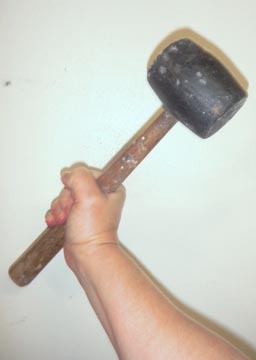
armatures into submission. Not so
with digital. HOLD ME BACK!
As a traditional sculptor who has spent 30 years of creating physical objects I am moving into digital technology and instead of just creating in my dusty studio, I am also creating within the box, the computer, that is on my desk, in my office. Presently I am working on the mesh or ZSpheres of a model in Pixologic’s ZBrush. I’m moving on to the 6th revision of this model. It is as tedious, if not more so, as the creating of a traditional life-size or monumental armature, but it is also just as necessary.
Picture this; you are in the throws of creating traditionally. The art is materializing before your eyes and you have all of the excitement that goes along with it, but without a proper armature for you clay to sit on; the traditional sculptor knows that you can walk into your studio one morning and find that your masterpiece has crumbled to the ground, sagged or broken into pieces.
Here I sit. My tools are different. It is not a welding rod, spray foam, chicken wire and mallet. It is a Cintiq tablet and a stylus pen. I have pushed and pulled ZSpheres and struggled with the ZSphere model for a week. (Pixologic tutorials state that creating this digital armature would be much easier if I had ZBrush 3.5. Zbrush 3.5 is only offered to those working on the PC and not available to Mac users at this time. ) If I had it, then I would have access to ZSketch, a tool that the Pixologic web site states is, “A new technology based on the ZSphere which will let you freely create your models without restrictions.” This is supposed to be much more intuitive and more like traditional sculpting. It is supposed to make creating the digital armature model, or mesh easier. I would even resort to moving to a PC to create in the ZSketch if I had a copy of ZBrush 3.5 for the PC, and it was true about the miraculous ability of this ZSketch. Then I could bring the sculpture back into my Mac using ZBrush for sculpting.
The process of “easily” creating a model to sculpt on, from scratch, in either Pixologics ZBrush or Autodesk’s Mudbox, in this sculptor’s opinion, is the missing link in these “intuitive” sculpting programs. This is a huge hindrance for those traditional sculptors who might like to utilize these tools in their own workflow. Without an easy way of digital modeling your armature through pushing and pulling on the screen, it is necessary to incorporate other means of 3D modeling. That would mean learning a modeling program, such as 3D’s max, Maya, Cinema 4D, Lightwave, Carrara or blender. For me, these programs feel even less intuitive to the traditional sculpting process. Modeling in a software program does not compare to the traditional process of sculpting. Hiring someone to create a digital model for my artwork feels similar to the process of hiring someone to create a traditional armature and roughing in the design. To me, hiring someone makes the process feel less organic; I feel divorced from an integral part of the creative process.
Here I sit. My tools are different. It is not a welding rod, spray foam, chicken wire and mallet. It is a Cintiq tablet and a stylus pen. I have pushed and pulled ZSpheres and struggled with the ZSphere model for a week. (Pixologic tutorials state that creating this digital armature would be much easier if I had ZBrush 3.5. Zbrush 3.5 is only offered to those working on the PC and not available to Mac users at this time. If I had it, then I would have access to ZSketch, a tool that the Pixologic web site states is, “A new technology based on the ZSphere which will let you freely create your models without restrictions.” This is supposed to be much more intuitive and more like traditional sculpting. It is supposed to make creating the digital armature model, or mesh easier. I would even resort to moving to a PC to create in the ZSketch if I had a copy of ZBrush 3.5 for the PC, and it was true about the miraculous ability of this ZSketch. Then I could bring the sculpture back into my Mac using ZBrush for sculpting.
Though creating armatures both traditionally and digitally is tedious work, it is this primal time of the creation that the “feel” of a sculpture presents itself and entices the artist to the creative dance. Another option to modeling is to rough in a small sketch, in traditional clay. A simple roughed in clay that shows form and gesture. Then, scan this sculpture with a 3Dscanner. We are using the Next Engine Scanner in the process. This process is what I call tra-digi art. I discuss it process in the New Mudbox book “Digital Sculpting with Mudbox: Essential Tools and Techniques for Artists” By Bridgette Mongeon and Michael de la Flor. It is necessary to note that scanning is still not a smooth transition. It will be necessary to retopologize this scan to be able to work on it in either ZBrush or Mudbox. The reason is that scanned models are in triangles, and it is necessary to have a model made with quads, or you will, once again, have artifacts and problems down the road. For a better description of why this is important check out this wonderful video on Subdivision Topology: Artifacts at Guerilla CG.
Learning how to retopologize is not as difficult as learning modeling in another program, but it is still work, and not as “true to the process of traditional sculpting.”
So, back to ZSpheres. The frustration of working with ZSpheres without ZSketch can be compared to the experiences I have downstairs in the traditional studio space. The only difference is when a traditional sculpture will not bow to my will; I will take a hammer from my closet of tools and bang the armature into submission. This technique is also an excellent relief of some of my own creative frustration. Working in ZBrush with ZSpheres allows me to push and pull without the physical effort or the clay under my nails. But my digital armature is far from being complete or correct and I am beginning to feel the need for a hammer.
With 30 years of experience in a traditional studio, I intuitively know what will or will not work in armature building. In the traditional studio, the type of armature I make and the type of clay used will depend on what final results I am after. Is this wet clay or is it wax-based clay? Will I be cutting this sculpture off the armature and then hollowing it out for firing or will I be sawing the armature apart with a reciprocating saw, dividing it up into many pieces to go to a foundry for mold making and bonze casting? These are questions I ask myself before beginning a traditional armature. The answers give me direction to create the appropriate support.
I do not have this same experience or intuition of digital armature building. I have no doubt that in the very near future, I will be working along on my digital creation, long after the building of the model or mesh and then I will find I cannot get the tool to work properly. An artifact or a bump in the sculpture’s topology—the underlying armature, will most likely be the cause. I will not be able to smooth and I will not be able to sculpt. I will wish I spent more time on creating a proper ZSphere model.
As with traditional sculpture, I must know what my final output will be. If this sculpture creation, that sits within the computer, is to be used in animation, then this armature or model needs to be created in such a way that the final piece can be animated. Bad topology or a bad mesh can cause problems in texturing and even the final rendering. In other words, I will not be able to generate an image of my creation.
My plans are to continue on with this digital model and invite a seasoned pro to my office to look at my digital armature, and perhaps give me some solutions and tricks in working with ZSpheres. Meanwhile, I check with the Pixologic website daily, to see if they are announcing the Mac version of ZSketch, so that I may prove for myself that it certainly does work more like traditional sculpting. And oh yes, I’ll keep the hammer downstairs in the traditional studio, just incase I get the urge to bang my mesh into submission and in doing so destroy my very costly equipment.
*
Bridgette Mongeon is a sculptor and writer and co-author of the new book
“Digital Sculpting with Mudbox: Essential Tools and Techniques for Artists”
She is also the host of a new podcast called Art and Technology
“A fire side chat where innovation, creativity, technology and science meet. ” For more information visit the artists blog
*
This is a free article you are welcome to use it on your website or blog. It must incorporate the writer/artist credit above.
Please also download all of the photographs to your own server.
Having A Wonderful Time With This!
I’m having a wonderful time with the new Art and Technology podcasts. We recorded our third one this morning. It is about 3D and copyright. A huge topic, and one that I think we will talk about quite often on this podcast. Here is a link to the case that we discussed along with our own experiences and thoughts about digital technology and copyright issues. Last week I had Materialise on the podcast and they shared their process and some of the incredible new things that will be around for artists working in 3D that want to get their artwork out of the computer.
Next week I have another exciting conversation. These are really fire side chats. Informal conversations on different aspects of digital sculpting, and traditional sculpting. The entrance line to the podcast is…
” Welcome to the art and technology podcast at digtialsculpting.net.
A fireside chat where innovation, creativity, technology and science meet.”
Now I just need to get the website up. I’m working diligently at this. It will be a community of artists talking about different subjects.
New Artwork- Working On A Cameo
Creating a bas-relief, a portrait that is flat and appears to have dimension, is something that I am asked to do quite often but have not had the chance to create. In the past, with the busy commission schedule in the studio I rarely have time to play in something or experiment. It is something that I have enjoyed about my graduate studies, exploration with play, and I love documenting my work! Working with a bas-relief created digitally was a way to explore this new style of sculpting.
The inspiration behind this new direction is the many cameos that my mother has given to me over the years. Beautiful women are sculpted in a variety of materials. Of course sculpting that small, the size of a brooch is a bit tedious and hard on the eyes. Besides I didn’t just want to make any person, I wanted to do a specific person.I was wondering if I could create this type of art using tra-digi means( traditional and digital process). Here are some photographs of my first attempts. I’m going to try some others and then have them printed or milled out as jewelry.
3d Printing In Paper?
A wonderful link for MCOR. MCOR is a Swiss company who has created a 3d printer that will print in paper. For those who know about 3d printing the cost of the materials going through the printer is a great expense. But in the case of paper, that is not as expensive.
Learning About Retoplogizing—An Excellent Video!
Can I Really Digitally Print In Metal?
This is an excellent video that discusses Powder Metallurgy.
I know it seems like it is something that is not affordable not doable for the average person. But shapeways is making this connection to the common artist, the every day guy. Check out this video
And their prices are extremely affordable. http://www.shapeways.com/
3D Camp Houston Was A Success. Next Year Bigger And Better.
It was last Wednesday that my husband invited me to the 3D modelers and animators meetup. I was interested in the presentation on Zbrush by Johannes Huber. It was there that I met David Morris. David told me about a project he had been working on for just 8 weeks. It was a 3D camp, planned for this past weekend. He envisioned a place where people could get together and talk about 3D. My husband Mike delaflor and I jumped on board.

David was doing exactly what I wanted to do. I had actually been thinking about this for a year. I was going to do it this fall, but instead decided to perhaps make it a part of my graduate practicum. I had already talked to Next Engine, who have some wonderful affordable desk top scanners. Ex One who you have seen in previous posts. I have been contacting them about their direct metal printing and last month I went to see there printing sandcasting Molds. Ex One said when I was ready to get this going they would try to get Shapeways on board. For those of you who don’t know about Shapeways they are affordable service bureau for 3d digital printing, and they too are now offering digital printing in metal!
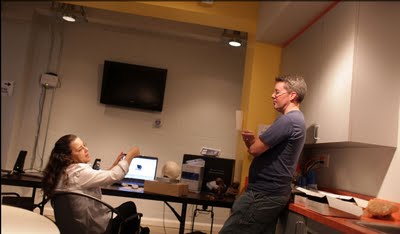
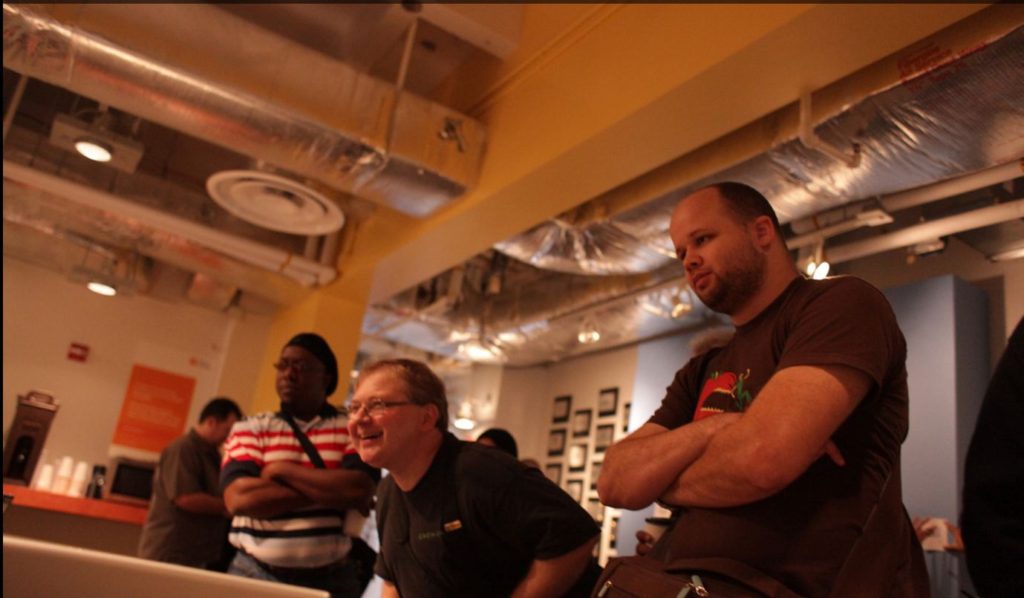
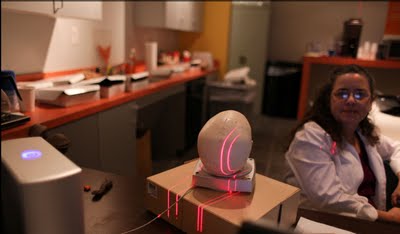
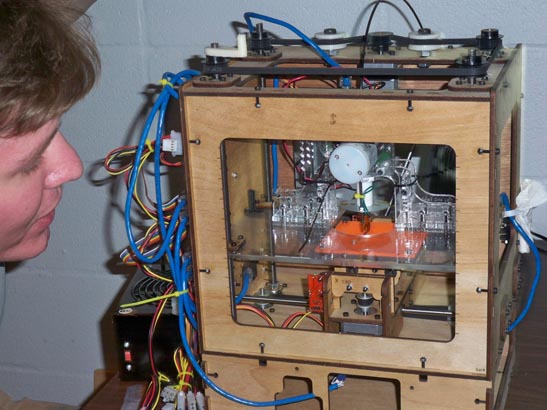
My goal was to get some vendors there and also offer some informative lectures on different processes of 3D. Well David did just that with 3D camp. I’m so excited and totally impressed with this young man. I think you will see this 3D camp grow in the up and coming years. I’m looking forward to presenting next year, and hopefully get the above vendors to demonstrate.
This year I demonstrated the 3D scanner, though I must say it was a crowded area and hard to get a good scan with so many people bumping the table. Still I get was able to sing the praises of this scanner that we are reviewing and using in our up and coming book, Digital Sculpting with Mudbox: Essential Tools and Techniques For Artists.
I also had this video playing and my article that I wrote for Sculpture Review on digital printing and milling where I talked about the incredible advances of Synappsys digital printing and their Data Direct to Mold process that is being used on The American.
My vantage point of 3D is coming from a traditional studio and using it to create traditional art. I suppose my focus then is a bit different than the traditional 3D artist. My graduate studies at Goddard- A Master of Fine Arts In Interdisciplinary Arts is based upon bridging the gap between the traditional and the digital studio. That is my interest. Though I have to admit, programs like Mudbox and Z brush are very intriguing and I expect I will be using them much more in the future. Oh no am I converting? Still I like the clay under my nails and my heart longs for dirty hands.
I encourage others to get involved with 3D camp next year, and plan on attending. I’m expecting it will double if not triple in size with a year of planning, some more backers, and some good promotion. If you would like to be a sponsore, If you are interested in presenting or are a vendor that would like to show at 3D camp next year please feel free to contact me or David.
Great job David!
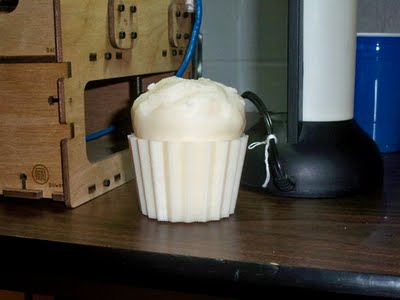
Some of my favorite things there revolve around output. This is a home made cnc router machine. To check it out further go to http://buildyourcnc.com/default.aspx
Many seemed to be interested in what a fine artist had to say in a 3D camp.
Another of my favorite had to again deal with output. It is the homemade 3D printer. This one is called the cupcake, and I must show that it can print a cupcake. I believe the cupcake costs about 700. to put together. There is another homemade one that I want to investigate but it costs approximately 3,000. Kind of steep to do for a hobby or to check out, but this other can print ceramic and chocolate, something worth investigating. I plan on reviewing all of these home made machines in an upcoming article.

